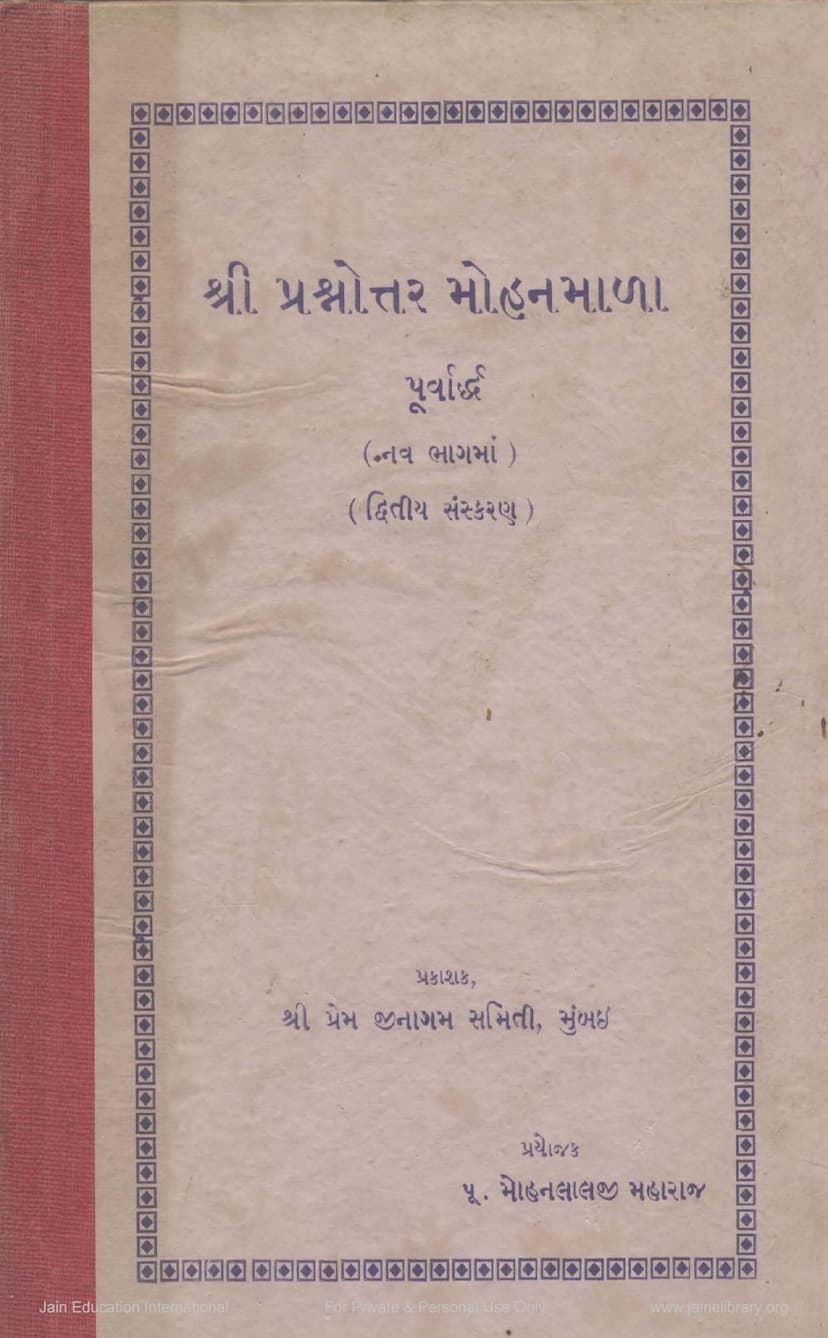Prashnottar Mohanmala Purvarddha
Added to library: September 2, 2025

Summary
This Jain text, "Prashnottar Mohanmala Purvarddha" by Mohanlalmuni, is a collection of questions and answers covering various aspects of Jain philosophy, ethics, and practices. The text delves into the nature of reality, the path to liberation (moksha), the classification of souls, karmas, and the conduct of monks and lay followers.
Here's a breakdown of the key themes and content, based on the provided pages:
1. Introduction and Core Principles:
- The text begins with devotional salutations (Shri Arhadvayo Namah).
- It emphasizes the importance of the "Saddharma" (the true dharma) as the ultimate means of salvation, freedom from suffering, and self-upliftment, achievable only through a "Sadguru" (true spiritual guide).
- The author, Muni Mohanlalji, highlights his personal spiritual journey, initiated by his guru, Shri Gopalji Swami, and his initiation into Jain monasticism at the age of 22.
- He describes his dedication to studying Jain scriptures and engaging in philosophical discussions, which led to the compilation of these questions and answers.
- The book's purpose is to clarify complex Jain doctrines through a question-and-answer format, making them accessible to the laity.
2. The Path to Liberation (Moksha Marga):
- The text defines "Dharma" as that which sustains beings in misfortune and elevates them to good states.
- It quotes scriptures emphasizing that Dharma is the highest good, leading to liberation and the shedding of sins.
- The path to liberation is identified as consisting of four components: Jnana (Knowledge), Darshan (Perception/Faith), Charitra (Conduct), and Tapa (Austerity). These are considered essential by both Jain and non-Jain traditions, though their interpretations may differ.
- The text stresses that while liberation is the ultimate goal, the path is arduous, with few successfully traversing it.
3. Understanding Karma and its Implications:
- The book explains that beings perform various actions (karmas), some yielding auspicious results and others inauspicious.
- It highlights that even great souls have had to endure inauspicious circumstances due to past karma, emphasizing that karma's fruition is inescapable.
- The text distinguishes between "Heuya Karma" (karma to be avoided) and "Upadaya Karma" (karma to be adopted), stating that understanding this distinction is crucial for progress. Without this knowledge, one cannot refrain from negative actions or engage in positive ones that lead to liberation.
- The necessity of Samyak Karma (right action) alongside right knowledge and perception is emphasized.
4. The Role of the Guru and Disciples:
- The text dedicates a significant portion to the role of the Guru, classifying disciples into seven types, using analogies like oysters, coconuts, rivers, and lakes to illustrate their receptivity to the Guru's teachings and their spiritual progress.
- It laments that in the modern era, both true Gurus and those capable of following them are rare.
- The author identifies the current times as having many disciples who fall into the latter four categories (lakes, Marwar land, stony ground, and rocky peaks), implying a lesser capacity to absorb and retain spiritual knowledge.
5. Key Jain Concepts Explained through Q&A: The book systematically addresses numerous Jain philosophical concepts through questions, including:
- Samkit (Right Faith): What it is, its types (Kshayak, Oupshamik, etc.), its importance, and how it is attained.
- Gati (States of Existence): Discussing the cycle of rebirth and the karmic causes for different states.
- Kashayas (Passions): Explaining the nature of anger, pride, deceit, and greed and their karmic implications.
- Jnan (Knowledge): Detailing the different types of knowledge (Mati, Shruta, Avadhi, Manahparyaya, Kevala) and their characteristics.
- Charitra (Conduct): Explaining the various stages and types of righteous conduct.
- Tapa (Austerities): Discussing the different forms and benefits of penance.
- Specific Concepts: Questions cover detailed aspects like the nature of soul, the difference between Jinas and other beings, the meaning of specific terms like "Pradesha Karma," "Anubhaga Karma," "Vigrahgati," "Avigrahgati," and the characteristics of different heavens and hells.
- The Nature of Existence: Explaining the five substances (Jiva, Ajiva, Pudgala, Dharma, Adharma, Akasha, Kala) and the concept of anekantavada (multi-faceted reality).
- Rituals and Practices: Addressing the significance of vows, fasting, and other practices.
6. Detailed Explanations:
- The text engages in detailed explanations of concepts like Moksha Marg (path to liberation), emphasizing the combined importance of knowledge, perception, conduct, and austerity.
- It clarifies the nature of Karma and how it binds the soul, mentioning specific karmic elements like Bandha (bondage) and Nirjara (shedding of karma).
- The distinction between Dravya (substance) and Paryaya (modes or qualities) is explored, particularly in relation to Pudgala (matter).
- The text scrutinizes the concept of Anekantavada (non-absolutism) and how it applies to Jain principles.
- It also covers specific questions about Kashayas (passions), Leshya (subtle colors of the soul), and the nature of Samyakdarshan (right perception).
7. Catalog Link: The provided catalog link (https://jainqq.org/explore/005265/1) points to a resource that likely holds digitized versions or detailed information about this specific text within a larger Jain library.
In essence, "Prashnottar Mohanmala Purvarddha" serves as a foundational text for understanding Jainism's core tenets, offering detailed answers to a wide range of spiritual and philosophical inquiries, guided by the author's deep knowledge of the scriptures and his spiritual lineage.